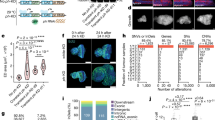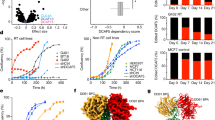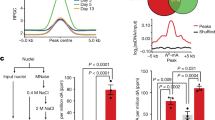Abstract
Smad nuclear interacting protein 1 (SNIP1) is an evolutionarily conserved protein containing a forkhead-associated (FHA) domain that regulates gene expression through interactions with multiple transcriptional regulators. Here, we have used short interfering RNAs (siRNAs) to knockdown SNIP1 expression in human cell lines. Surprisingly, we found that reduction in SNIP1 levels resulted in significantly reduced cell proliferation and accumulation of cells in the G1 phase of the cell cycle. Consistent with this result, we observed that cyclin D1 protein and mRNA levels were reduced. Moreover, SNIP1 depletion results in inhibition of cyclin D1 promoter activity in a manner dependent upon a previously characterized binding site for the AP-1 transcription factor family. SNIP1 itself is induced upon serum stimulation immediately prior to cyclin D1 expression. These effects were independent of the tumour suppressors p53 and retinoblastoma (Rb), but were consistent with an interaction with BRG1, a component of the ATP-dependent chromatin remodelling complex, Swi/Snf. These results define both a new function for SNIP1 and identify a previously unrecognized regulator of the cell cycle and cyclin D1 expression.
This is a preview of subscription content, access via your institution
Access options
Subscribe to this journal
Receive 50 print issues and online access
$259.00 per year
only $5.18 per issue
Buy this article
- Purchase on Springer Link
- Instant access to full article PDF
Prices may be subject to local taxes which are calculated during checkout








Similar content being viewed by others
References
Albanese C, Johnson J, Watanabe G, Eklund N, Vu D, Arnold A and Pestell RG . (1995). J. Biol. Chem., 270, 23589–23597.
Anderson LA and Perkins ND . (2002). J. Biol. Chem., 277, 29550–29554.
Anderson LA and Perkins ND . (2003). Mol. Cell. Biol., 23, 721–732.
Beadling C, Cereseto A, Fan W, Naramura M and Smith KA . (2001). Oncogene, 20, 1771–1783.
Bradney C, Hjelmeland M, Komatsu Y, Yoshida M, Yao TP and Zhuang Y . (2003). J. Biol. Chem., 278, 2370–2376.
Brummelkamp TR, Bernards R and Agami R . (2002). Science, 296, 550–553.
Chehab NH, Malikzay A, Appel M and Halazonetis TD . (2000). Genes Dev., 14, 278–288.
Durocher D, Taylor IA, Sarbassova D, Haire LF, Westcott SL, Jackson SP, Smerdon SJ and Yaffe MB . (2000). Mol. Cell, 6, 1169–1182.
Girdwood D, Bumpass D, Vaughan OA, Thain A, Anderson LA, Snowden AW, Garcia-Wilson E, Perkins ND and Hay RT . (2003). Mol. Cell, 11, 1043–1054.
Goldberg M, Stucki M, Falck J, D'Amours D, Rahman D, Pappin D, Bartek J and Jackson SP . (2003). Nature, 421, 952–956.
Goodman RH and Smolik S . (2000). Genes Dev., 14, 1553–1577.
Grossman SR, Perez M, Kung AL, Joseph M, Mansur C, Xiao ZX, Kumar S, Howley PM and Livingston DM . (1998). Mol. Cell, 2, 405–415.
Hofmann K and Bucher P . (1995). Trends Biochem. Sci., 20, 347–349.
Ito T, Yamauchi M, Nishina M, Yamamichi N, Mizutani T, Ui M, Murakami M and Iba H . (2001). J. Biol. Chem., 276, 2852–2857.
Kim RH, Flanders KC, Reffey SB, Anderson LA, Duckett CS, Perkins ND and Roberts AB . (2001). J. Biol. Chem., 276, 46297–46304.
Kim RH, Wang D, Tsang M, Martin J, Huff C, de Caestecker MP, Parks WT, Meng XW, Lechleider RJ, Wang TW and Roberts AB . (2000). Genes Dev., 14, 1605–1616.
Lee CH and Chung JH . (2001). J. Biol. Chem., 276, 30537–30541.
Muchardt C and Yaniv M . (2001). Oncogene, 20, 3067–3075.
Peterson CL and Workman JL . (2000). Curr. Opin. Genet. Dev., 10, 187–192.
Pierrou S, Hellqvist M, Samuelsson L, Enerback S and Carlsson P . (1994). EMBO J., 13, 5002–5012.
Rocha S, Campbell KJ and Perkins ND . (2003a). Mol. Cell, 12, 15–25.
Rocha S, Martin AM, Meek DW and Perkins ND . (2003b). Mol. Cell. Biol., 23, 4713–4727.
Rocha S, Soengas MS, Lowe SW, Glanzmann C, Fabbro D, Winterhalter K, Bodis S and Pruschy M . (2000). Cell Growth Differ., 11, 491–499.
Vogelstein B, Lane D and Levine AJ . (2000). Nature, 408, 307–310.
Watanabe G, Lee RJ, Albanese C, Rainey WE, Batlle D and Pestell RG . (1996). J. Biol. Chem., 271, 22570–22577.
Webster GA and Perkins ND . (1999). Mol. Cell. Biol., 19, 3485–3495.
Weinstatsaslow D, Merino MJ, Manrow RE, Lawrence JA, Bluth RF, Wittenbel KD, Simpson JF, Page DL and Steeg PS . (1995). Nat. Med., 1, 1257–1260.
Wilson JA, Jayasena S, Khvorova A, Sabatinos S, Rodrigue-Gervais IG, Arya S, Sasrangi F, Harris-Brandts M, Beaulieu S and Richardson CD . (2003). Proc. Natl. Acad. Sci. USA, 100, 2783–2788.
Yao TP, Oh SP, Fuchs M, Zhou ND, Ch'ng LE, Newsome D, Bronson RT, Li E, Livingston DM and Eckner R . (1998). Cell, 93, 361–372.
Zhou MM . (2000). Nat. Struct. Biol., 7, 1085–1087.
Acknowledgements
We are particularly grateful to Dr Anita Roberts for help, assistance and encouragement to investigate SNIP1. We thank Maren Oehlmann for help with gel filtration analysis, Rosie Clarke for help with FACS analysis, all the members of the NDP laboratory and the Division of Gene Regulation and Expression at the University of Dundee for their help and assistance. NDP is funded by a Royal Society University Fellowship, KCR was formally a BBSRC PhD student but is now funded by the Association of International Cancer Research (AICR). TOH and NW are funded by a Wellcome Trust Senior Research Fellowship.
Author information
Authors and Affiliations
Corresponding author
Rights and permissions
About this article
Cite this article
Roche, K., Wiechens, N., Owen-Hughes, T. et al. The FHA domain protein SNIP1 is a regulator of the cell cycle and cyclin D1 expression. Oncogene 23, 8185–8195 (2004). https://doi.org/10.1038/sj.onc.1208025
Received:
Revised:
Accepted:
Published:
Issue Date:
DOI: https://doi.org/10.1038/sj.onc.1208025
Keywords
This article is cited by
-
SNIP1 and PRC2 coordinate cell fates of neural progenitors during brain development
Nature Communications (2023)
-
LncRNA BCAN-AS1 stabilizes c-Myc via N6-methyladenosine-mediated binding with SNIP1 to promote pancreatic cancer
Cell Death & Differentiation (2023)
-
The DcPS1 cooperates with OSDLa during pollen development and 2n gamete production in carnation meiosis
BMC Plant Biology (2022)
-
KMT5A-methylated SNIP1 promotes triple-negative breast cancer metastasis by activating YAP signaling
Nature Communications (2022)
-
MYC: a multipurpose oncogene with prognostic and therapeutic implications in blood malignancies
Journal of Hematology & Oncology (2021)



